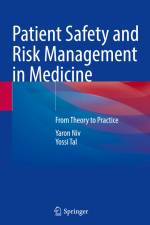av Yossi Tal
1 419,-
Medical errors can have serious consequences, often resulting in harm to patients or even death. In the last decades the issue of the 2nd victim was raised, emphasizing the impact of being involved in an adverse event on the ability of caregivers to provide high quality and safe treatment. In 1999, the American Institute of Medicine (IOM) declared that rather than assigning blame for these errors, professional investigations should be carried out to identify what caused them and prevent similar events from reoccurring in the future focusing on systemic factors. It is estimated that in the US alone, there are between 250,000 to 400,000 preventable deaths annually due to medical errors, costing over 15 billion dollars per year. In response to this challenging issue, a team of medical professionals has created a comprehensive textbook on the subject of safety and risk management in medicine. This book covers a range of topics, including basic principles and concepts, the scope of iatrogenic harm, the development of risk management in medicine, and the organizational safety culture. Emphasis is placed on the human and organizational factors that contribute to medical errors, as well as practical methods and tools for coping effectively with this phenomenon. The book is based on extensive practical experience in promoting patient safety in a variety of medical organizations. In addition, the book includes a large chapter on risk management during epidemics, which has become increasingly relevant in the wake of the COVID-19 pandemic. This textbook is a must-read for anyone involved in patient care, including doctors, nurses, managers, pharmacists, psychologists, occupational therapists, physiotherapists and students in all medical professions. By promoting a culture of safety and risk management, we can work towards reducing the number of preventable medical errors and improving patient outcomes.

